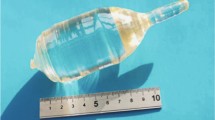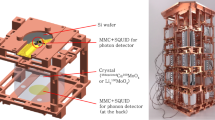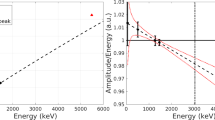Abstract
The AMoRE collaboration is preparing for the AMoRE-II experiment that will probe neutrinoless double beta decay with 100 kg of 100Mo isotope. The 100Mo nuclide will be mainly in the form of lithium molybdate crystals that are instrumented with metallic magnetic calorimeters (MMC), which detect the phonon excitations produced by electrons from neutrinoless double beta decay in the crystals. The energy resolution at a Q-value = 3.034 MeV is around 10 keV within a temperature ranging between 10 and 20 mK. Increasing the crystal mass of individual detector modules will reduce the number of detector channels and allow a few practical advantages associated with crystal growing, detector preparation, and operation of the experiment. To this end, we carried out an experiment with a 6 cm (diameter (D)) × 6 cm (height (H)) cylindrical lithium molybdate crystal of 516 g mass, which is 73% more massive than the 5 cm (D) × 5 cm (H) crystals that are currently being used in the AMoRE-I setup. We found that the larger crystal detector shows good performance characteristics in terms of energy resolution, signal time constant and particle identification capability, which makes it a suitable option for the AMoRE-II experiment.




Similar content being viewed by others
Data Availability
All data generated or analysed during this study are included in this published article [and its supplementary information files].
References
M. Dolinski et al., Neutrinoless double-beta decay: status and prospects. Annu. Rev. Nucl. Part. Sci. 69, 219 (2019). https://doi.org/10.1146/annurev-nucl-101918-023407
V. Alenkov et al., First results from the AMoRE-Pilot neutrinoless double beta decay experiment. Eur. Phys. J. C 79, 791 (2019). https://doi.org/10.1140/epjc/s10052-019-7279-1
M.H. Lee, AMoRE: a search for neutrinoless double-beta decay of 100 Mo using low-temperature molybdenum-containing crystal detectors. JINST 15, C08010 (2020). https://doi.org/10.1088/1748-0221/15/08/C08010
Y. M. Oh, et al., In preparation
B. Alexander, Precise half-life values for two-neutrino double-\(\beta\) decay: 2020 review. Universe 6, 159 (2020). https://doi.org/10.3390/universe6100159
G.B. Kim et al., Novel measurement method of heat and light detection for neutrinoless double beta decay. Astropart. Phys. 91, 105 (2017). https://doi.org/10.1016/j.astropartphys.2017.02.009
I. Kim et al., Application of metallic magnetic calorimeter in rare event search. Supercond. Sci. Technol. 30, 094005 (2017). https://doi.org/10.1088/1361-6668/aa7c73
G.B. Kim et al., Heat and light measurement of a crystal for the AMoRE double beta decay experiment. IEEE Trans. Nucl. Sci. 63, 539 (2016). https://doi.org/10.1109/TNS.2015.2493529
D. Drung et al., Highly sensitive and easy-to-use SQUID sensors. IEEE Trans. Appl. Supercond. 17, 699 (2007). https://doi.org/10.1109/TASC.2007.897403
S.G. Kim et al., Low temperature property study of MMCs Used for neutrinoless double beta decay. IEEE T. Appl. Supercon. 31, 2300205 (2021). https://doi.org/10.1109/TASC.2021.3066179
C. Lee et al., Vibration isolation system for cryogenic phonon-scintillation calorimeters. JINST 12, C02057 (2017). https://doi.org/10.1088/1748-0221/12/02/C02057
F. Fröbst et al., Model for cryogenic particle detectors with superconducting phasetransition thermometers. J. Low Temp. Phys. 100, 69 (1995)
Acknowledgements
This research is supported by Grant Nos. IBS-R016-A2 and IBS-R016-D1.
Author information
Authors and Affiliations
Corresponding author
Additional information
Publisher's Note
Springer Nature remains neutral with regard to jurisdictional claims in published maps and institutional affiliations.
Rights and permissions
Springer Nature or its licensor holds exclusive rights to this article under a publishing agreement with the author(s) or other rightsholder(s); author self-archiving of the accepted manuscript version of this article is solely governed by the terms of such publishing agreement and applicable law.
About this article
Cite this article
Kim, W.T., Kim, S.C., Sharma, B. et al. Test Measurements of an MMC-Based 516-g Lithium Molybdate Crystal Detector for the AMoRE-II Experiment. J Low Temp Phys 209, 299–307 (2022). https://doi.org/10.1007/s10909-022-02832-7
Received:
Accepted:
Published:
Issue Date:
DOI: https://doi.org/10.1007/s10909-022-02832-7




